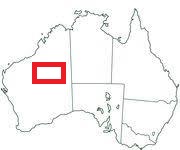

Yellow colour - unsuppported trip
Orange colour - supported with food pick up/purchase
Movie Stage V
| start date | activity | place | from - to | days | km | km/ day | comment |
| 3.05 | desert cart | West Talawana Track | Len Beadel Marker - Georgia Bore | 7 | 202 | 34 | Last seen human 7th May |
| 10.05 | desert cart | Canning Stock Route/Talawana | Georgia Bore - Midway Well | 5 | 130 | 28 | Last washing |
| 15.05 | desert cart | East Talawana Track | Midway Well - Windy Corner | 6 | 121 | 19 | Extreme Track Condition |
| 21.05 | desert cart | Gibson Desert | Windy Corner - Patjarr | 9 | 195 | 22 | off-road |
| 30.05 | rest | Patjarr | 1 | 0 | 0 | First met man after 22 days |
I couldn't sleep. The same questions were running through my mind all the time: Do I really know what I am doing? Will I haul a 170 kg desert cart over the dune? What if there is no water in the planned place? What if the body or equipment fails? What if I am running out of food or water? What if something bad happens to me? However when the fear was seizing my mind I was already there, isolated, on my own. I had no turning back option.

He reinforced my uncertainty that never changed in my head until the end - I was under stress all the time. At noon, when it was hot and I was lying in the shadow of the cart, I was wondering if I am normal, wasn't be better to stay in a safe house?
Oh, I was way beyond my comfort zone, I was just scared. However, it was too late to change my mind.
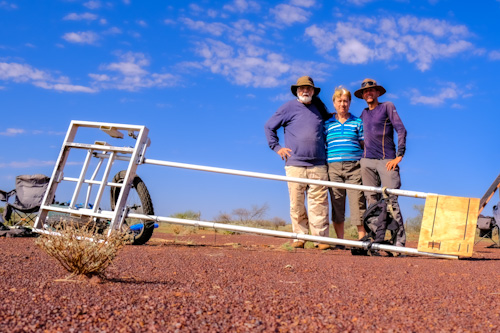
Finding Joe and Maria Furulyas in a mine town like Newman is like winning the lottery. In addition to hospitality and delicious food, Joe had stored my cart for months and now helped me put the wheel back together after I smashed the bearing on the wheelbarrow section. We had a lot of misadventures with the bearing and the washer, it cost me an additional two days of delay. Joe also agreed to take my cart over 200km away (where I cycled in two days instead of 7 days on foot along a boring road), from where I started the desert stage.
Initially, Talawana Track was very nice, good surface and wide gravel road. After 6 days, the main road turned off and I was left on a narrow, sandy track. I entered more remote area.

 I set off into the sand before sunrise, hoping that the morning moisture would help the sand to be less powdery. Unfortunately, even deflating the tires did not help much - hard work, the pace of 1 km/h and a break every minute to calm down the heart beat. I knew that I could not do it this way. Fortunately, after 2 km, the trail's ground hardened a bit and my posture took on more vertical shapes, I didn't have to restrain my legs and poles anymore too often, at least from time to time I had a break from the sand.
I set off into the sand before sunrise, hoping that the morning moisture would help the sand to be less powdery. Unfortunately, even deflating the tires did not help much - hard work, the pace of 1 km/h and a break every minute to calm down the heart beat. I knew that I could not do it this way. Fortunately, after 2 km, the trail's ground hardened a bit and my posture took on more vertical shapes, I didn't have to restrain my legs and poles anymore too often, at least from time to time I had a break from the sand.
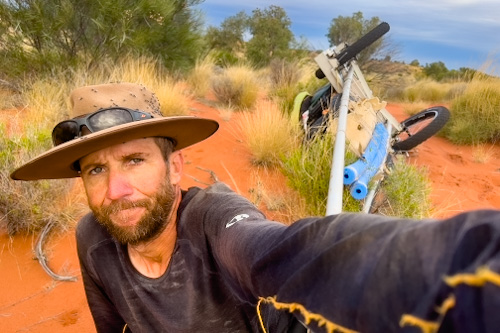 Remembering the dehydration on the second day of the trip, I was carrying a lot of H2O with me, which means that I was heavy. With the next sandy stretches, I found it was easier for me to go off-road, parallel to the trail. And it worked. Unfortunately, I made a mistake and during one of my return to the main trail I rolled the cart at an angle - a crash, a creak, it bends me, I felt that the cart was tilting, and I am between two aluminum poles. I struggled out of the bent poles, sat down, and ate some Nutella, wondering if this was the end of the journey. I wasn't injured, but they are there any equipment issues? The miracle - no serious structural damage. I learned a good lesson, concentration must be maximaised.
Remembering the dehydration on the second day of the trip, I was carrying a lot of H2O with me, which means that I was heavy. With the next sandy stretches, I found it was easier for me to go off-road, parallel to the trail. And it worked. Unfortunately, I made a mistake and during one of my return to the main trail I rolled the cart at an angle - a crash, a creak, it bends me, I felt that the cart was tilting, and I am between two aluminum poles. I struggled out of the bent poles, sat down, and ate some Nutella, wondering if this was the end of the journey. I wasn't injured, but they are there any equipment issues? The miracle - no serious structural damage. I learned a good lesson, concentration must be maximaised.
After going off the difficult Canning trail, pulling the stroller was a little easier. Still hard, but not tragic. So I could admire the surroundings, chase the camels, enjoy the camp fire at sunset, bake bread. I fell into a routine of exercise, meals, camping. And minutes passed, then hours, days and weeks.


Midway Well - will be there water, no one could confirm 100%. The cauncil did not call back, the police told me to google, internet forums had contradictory information.
Fortunately, the hand pump worked and I took the maximum amount of water - 94 liters in total, which together with 20 kg of food and the rest of the equipment, including the weight of the cart itself, made 170 kg!
 Unfortunately, things got worse from then on. Starting with encounter an aggressive dingo. I was drying things out and the dog really wanted to bite something, so I pushed him away and packed things hiding behind the cart. So she walked around and tried on the other side and I kept on holding my trekking poles towards her and she kept barking. Suddenly she has gone - I looked, and there were more dingos. They will eat me alive - I thought.
Unfortunately, things got worse from then on. Starting with encounter an aggressive dingo. I was drying things out and the dog really wanted to bite something, so I pushed him away and packed things hiding behind the cart. So she walked around and tried on the other side and I kept on holding my trekking poles towards her and she kept barking. Suddenly she has gone - I looked, and there were more dingos. They will eat me alive - I thought.
The dog, however, came back alone, and at that time I was prepared with a knife and a branch, which I managed to light up quickly - this was what the dog was afraid of. The fire, however, was over after a minute and the fun was over again. When she left once again, then I moved on, the dog was following me but no longer barking and did not try to bite. After a few hours, I didn't see her anymore.
The second misfortune of the day was the Talawana Track itself. From then on, the trail was in a tragic condition. Firstly, it was overgrown with spinifex, high and dense, so that every half a meter I had to struggle to pull wheels over it. Because unfortunately the trail was too wide for my wheels to match both car's tracks, while a single track was too narrow for my cart width to fit - it was a brutal job for the next 6 days.
The facts speak for themselves:
for the first 7 hours I did 10km and was exhausted;
it was sometimes so dense bush that I had to cover my face, until one time I lost the trail and had to go back to find it;
when I finished 111km of hardship track, the first day of wandering off-road brought a greater distance covered than on the trail.
When I finally reached Windy Corner which is the eastern end of Talawana, and at the same time the end of the Little Sandy Desert which I managed to cross unsupported, I realized that I was very behind the schedule with the distance, and thus - I could have had not enough food and water. So from now on there were stressful activities combined - covering the minimum daily distance, the limit on eating and drinking water, and navigation challenge.

However, when I was pulling the cart moving about 1.5 km/h, the mental stress and physical exertion pierced me right through. I quickly learned that my planned route was useless here, as practice proved that the most dense vegetation is on the lower parts of the terrain, and a little better on the elevated parts. There is no difference in the satellite images. As I walked, I started to recognize minimal differences in the color of spinifex, where one was easier to walk than the other, also a certain kind of trees was the most valuable for me, as there was minimal grass in the area. There was no choice, I had to change my route.
So every evening I sat over the topographic map and planned the theoretically the fastest route - as elevated as possible, and avoided crossing over dry creek beds. The next day I was putting it into practice trying to find the best solution between the shortest and the easiest way. So I came up with a march on two azimuths - I could only move between the direction indicated by the traditional compass and the GPS compass, and the rest was determined by observation, experience and intuition.
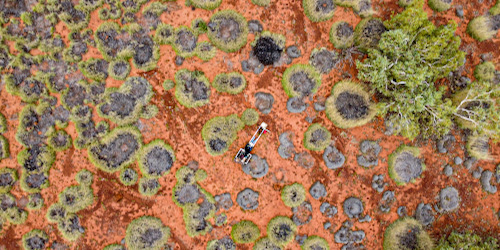
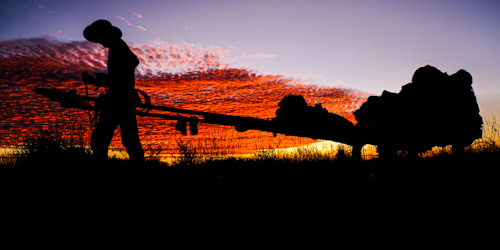
Sometimes a tragedy for half a day, and then suddenly the terrain improves. I walk in loose sand and a kilometer later on a hard surface. I am happy like a child, and a minute later I curse on the rocky ground. It happened that for several hours in a row spinifex grasses effectively reduced my patience and self-confidence.
During hotter breaks at noon, I would lie down in the shade of a bush or a cart and try to rest, but sometimes the angry ants would not let me - in fury they climbed under my pants and T-shirt and bit, not letting me relax.
 Needless to say, every day I started walking before sunrise (the alarm was not needed, stress did not allow otherwise), and ended after sunset, as long as it was possible to navigate. The water was filtered every few days after the end of the day, because it was a few hours of work. And so after a few days of such labor I started to feel my knee, one muscle, then another - so massages, creams, supplement vitamins, warming up by the fire, changing the restraining legs to save the hard preassure on weaker limb, more involvement of hands and torso for dragging a cart through these clumps of grass. And somehow it rolled over. The injury would have deprived me of illusions, as well as a serious equipment failure - so far only one spoke broke, and the rest worked.
Needless to say, every day I started walking before sunrise (the alarm was not needed, stress did not allow otherwise), and ended after sunset, as long as it was possible to navigate. The water was filtered every few days after the end of the day, because it was a few hours of work. And so after a few days of such labor I started to feel my knee, one muscle, then another - so massages, creams, supplement vitamins, warming up by the fire, changing the restraining legs to save the hard preassure on weaker limb, more involvement of hands and torso for dragging a cart through these clumps of grass. And somehow it rolled over. The injury would have deprived me of illusions, as well as a serious equipment failure - so far only one spoke broke, and the rest worked.
Mental comfort was given by writing SMS via GPS, contact with family and friends brought a little escape from reality. One day there was also an SMS from Joe Baldi who supported me with information and suggestions in front of his computer. He saw what was infront of me on satellite images, followed my current position and shared statistical or practical information several times a day - at that point it was very important mental support, it helped me enormously. I wrote once that I did not want to die here, and I was very serious when writing about it. Because you do not call the satellite phone for help when there is still hope that you will finish by yourself, you do not call the army when you still have 10 liters of water ... a desperate decision must take place when the situation would be completely hopeless - only if then there would be enough time to wait for the rescue to arrive whether then you are able to think rationally, or… how good that I didn't have to know those answers.

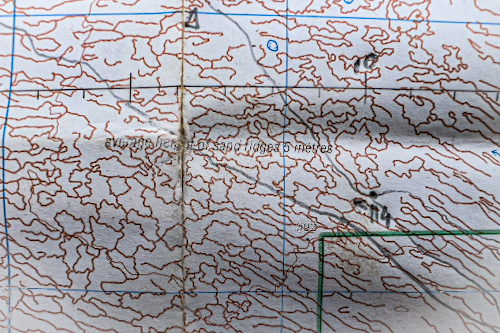
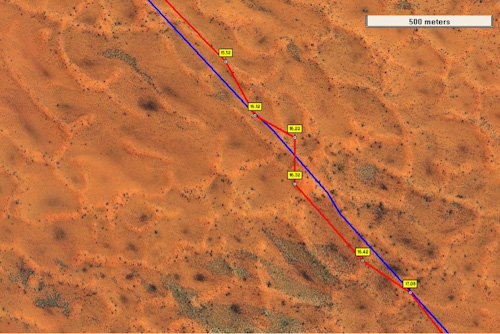
When I went through this maze and the space between the next dunes opened a bit, I could finally say that this time I will get there. Unfortunately, I ran out of snacks, sweets or supplements. I was terribly hungry, to the point where, for example, a few coconut flakes fell off on the ground, so like everything that landed in the sand I put it back in my mouth, but this time the food "ran away". Then I chased such an ant and pulled her out my very little flake of coconut.
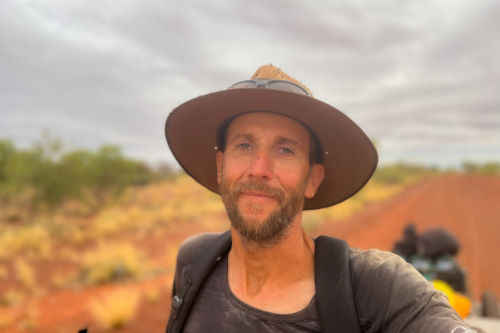 Due to fatigue, my legs were already losing ground, I landed with my face on my dashboard. Then my cart flipped out twice and rolled over on its side, with me strapped in. Fortunately, not on the dune slope, so I did not tumble, but in a relatively simple situation - it showed my poor concentration and physical fatigue, because I wanted to end this stage very much and finally feel safe. I've been under stress for too long.
Due to fatigue, my legs were already losing ground, I landed with my face on my dashboard. Then my cart flipped out twice and rolled over on its side, with me strapped in. Fortunately, not on the dune slope, so I did not tumble, but in a relatively simple situation - it showed my poor concentration and physical fatigue, because I wanted to end this stage very much and finally feel safe. I've been under stress for too long.
In the end, everything ended suddenly - I found the old trail, then the path, and when I saw the 4WD track, only then I was overcome by a great relief. I'm safe! After an hour I entered the settlement of Patjarr, after all, at this stage I did not see a man for 22 days - this is my absolute personal best record. I probably will never beat it again.
I can say that I managed to cross the deserts thanks to the perfect weather - I didn't have many very hot days, and sometimes I felt the wind on my face, and it was rainy twice! Thanks to the above combination, I have more water left.
Statistics:
Crossing the entire Little Sandy Desert from west to east (453 km in 18 days) along the Talawana Track and part of the Gibson Desert off-road (195 km in 9 days)
No third party support from 9km mark where I got tea. On the 5th day at 130km mark, I got a bottle of water and two oatmeal bars, but I didn't use them until the end of the walk
Start to Georgia Bore - good gravel road, 202km, 7 days, average 34km with a full day walking, last man seen on day 5
Georgia Bore to Midway Well - difficult sandy road including the Canning Stock Route, 60 liters of water, 130 km, 5 days, average 28 km with a full day of walking
Midway Well to Windy Corner - a very difficult path overgrown with grass and bushes, a walk with 94 liters of water (170 kg all with a stroller), 121 km, 6 days, average 19 km with a full day of walking
Windy Corner to Patjarr - off-road, super hard mentally and physically, 195km, 9 days, average 22km with a full day of walking
Total of 648 km, 27 days (22 without human), the average 25 km with a full day of walking

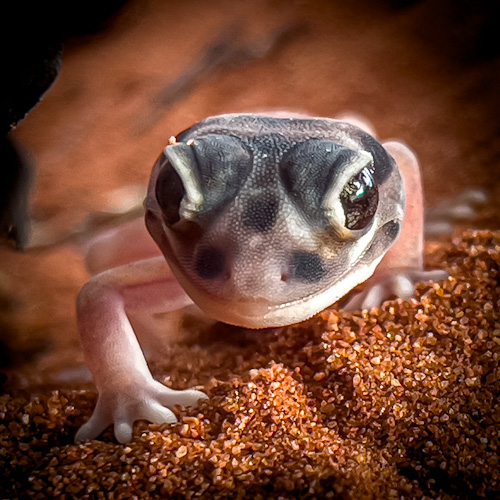

Average water consumption (drinking, cooking, washing initially) was 5.4 liters per day.
The worst was a day without sun, but with high humidity, 7.3 liters, but on a rainy day the least was 2.7 liters
The caloric consumption for the first two weeks was 3400 calories per day, then I introduced quantitative restrictions
Distance covered without "refueling" - 15 days, 316 km
A strange feeling when during the whole month of May I did not eat any fresh vegetables, spent not a single dollar, did not have phone coverage - just another world.